
2005 International Aluminum Extrusion Design Competition
Student Class Winning Entries

First Place: Ramp XY, Submitted by Diogo Mangas
Second Place: Extruded Computer Mouse, Submitted by John Paul Gucciardo
Third Place: MiniBrite Task Light, Submitted by David Rivera
Hydro Sustainable Design Award:
• Award Winner: Mobile Sediment Pond Barrier, Submitted by Jared Crooks
• Honorable Mention: Salmon Ladder, Submitted by Adam Bancroft
• Honorable Mention: Produce Container, Submitted by Paula Martins
• Honorable Mention: Thermoelectric Device, Submitted by Eric LaFay
First Place: Ramp XY, Submitted by Diogo Mangas
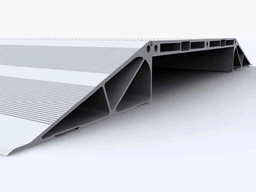 First Place, with a $3,000 cash award, was presented to Diogo Mangas for his design of the Ramp XY. Mangas, a senior studying industrial design at ESAD, Escola Superior de Artes e Design, in Caldas da Rainha, Portugal, designed the extruded aluminum ramp "to solve some of the problems experienced in those places where vehicles have to cross difficult obstacles." The ramp comprises several extrusions of different shapes and dimensions that combine to form a large number of ramps. Mangas explained that the ramp was designed to be articulate so that it can be used to traverse smaller obstacles such as wires, hoses, and doorsteps, as well as larger obstacles such as empty stairway spaces and other uneven surfaces. "This design is a very practical application for solving a problem," commented Design Competition judge Bruce R. Kasten, Vice President of Sales and Marketing for Penn Aluminum in Murphysboro, Illinois.
First Place, with a $3,000 cash award, was presented to Diogo Mangas for his design of the Ramp XY. Mangas, a senior studying industrial design at ESAD, Escola Superior de Artes e Design, in Caldas da Rainha, Portugal, designed the extruded aluminum ramp "to solve some of the problems experienced in those places where vehicles have to cross difficult obstacles." The ramp comprises several extrusions of different shapes and dimensions that combine to form a large number of ramps. Mangas explained that the ramp was designed to be articulate so that it can be used to traverse smaller obstacles such as wires, hoses, and doorsteps, as well as larger obstacles such as empty stairway spaces and other uneven surfaces. "This design is a very practical application for solving a problem," commented Design Competition judge Bruce R. Kasten, Vice President of Sales and Marketing for Penn Aluminum in Murphysboro, Illinois.
Second Place: Extruded Computer Mouse, Submitted by John Paul Gucciardo
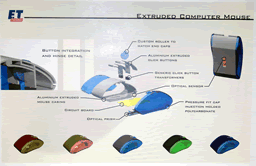 Second Place in the Student Class, with a $2,000 cash prize, was awarded to John Paul Gucciardo, a junior studying industrial design at Dawson College in Montréal, Quebec. His design of an extruded aluminum computer mouse in an array of anodized colors intrigued the judges. "It integrates design and new technology," explained the designer. "It allows for a unique styling and may last longer than plastic." "With the trend in the computer industry towards aluminum products, this extruded mouse would fit right in," noted Design Competition judge Angel Rosario, Applications Engineer for Alcoa Engineered Products in Chicago. "Wow! What a great idea," commented Kasten. "While the idea of a computer mouse is not revolutionary, the application for aluminum extrusion is a concept the technology world should incorporate. The pizzazz this product offers combining extrusions and bright colors is consistent with marketability concepts currently employed by the computer industry."
Second Place in the Student Class, with a $2,000 cash prize, was awarded to John Paul Gucciardo, a junior studying industrial design at Dawson College in Montréal, Quebec. His design of an extruded aluminum computer mouse in an array of anodized colors intrigued the judges. "It integrates design and new technology," explained the designer. "It allows for a unique styling and may last longer than plastic." "With the trend in the computer industry towards aluminum products, this extruded mouse would fit right in," noted Design Competition judge Angel Rosario, Applications Engineer for Alcoa Engineered Products in Chicago. "Wow! What a great idea," commented Kasten. "While the idea of a computer mouse is not revolutionary, the application for aluminum extrusion is a concept the technology world should incorporate. The pizzazz this product offers combining extrusions and bright colors is consistent with marketability concepts currently employed by the computer industry."
Third Place: MiniBrite Task Light, Submitted by David Rivera
Third place in the Student Class, winning a $1,000 cash prize, was awarded to David Rivera, a third-year industrial design 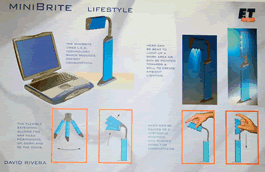 student at Dawson College in Montréal, Quebec, for his design of the MiniBrite Task Light. "This new concept uses the rectilinear qualities of extrusion to enhance the overall aesthetic appeal of the final product and to create a retractable sliding mechanism," explained Rivera. "Using the extrusion process also simplifies assembling and reduces other costs related to secondary operations." The light is designed to be energy efficient by using recycled aluminum and using LED (light emitting diode) as a light source, which greatly reduces energy consumption, according to the designer. Rosario sees potential success with the design and offered some marketing advice. "Maybe the second and third place winners should get together and bundle their products to the computer industry," he remarked.
student at Dawson College in Montréal, Quebec, for his design of the MiniBrite Task Light. "This new concept uses the rectilinear qualities of extrusion to enhance the overall aesthetic appeal of the final product and to create a retractable sliding mechanism," explained Rivera. "Using the extrusion process also simplifies assembling and reduces other costs related to secondary operations." The light is designed to be energy efficient by using recycled aluminum and using LED (light emitting diode) as a light source, which greatly reduces energy consumption, according to the designer. Rosario sees potential success with the design and offered some marketing advice. "Maybe the second and third place winners should get together and bundle their products to the computer industry," he remarked.
Hydro Sustainable Design Award
The Sustainable Design award, established by Hydro Aluminum North America for the competition, recognizes the student entry that best addresses societal and/or environmental concerns. "We were most impressed by the overall quality of the entries," commented Lynn Brown, Vice President of Communications and External Affairs for Hydro Aluminum North America in Linthicum, Maryland. "The selection process this year was significantly more challenging. In the end, four entries stood out—both for the way they addressed sustainability issues and the originality of the applications and the design solutions." For those reasons, Hydro chose one winning entry and three entries worthy of Honorable Mentions.
Award Winner: Mobile Sediment Pond Barrier, Submitted by Jared Crooks
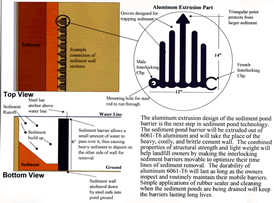 Jared Crooks, a senior mechanical engineering student from Ohio University in Athens, Ohio, won the Hydro Sustainable Design Award, earning $2,000, for his design of a Mobile Sediment Pond Barrier. "The aluminum extrusion design of the sediment pond barrier is the next step in sediment pond technology," explained Crooks. Lynn Brown agreed. "He has addressed the challenge of improving the runoff water quality around landfills. Today, cement walls are used as a sediment barrier. Jared’s extrusion design is a portable, longer lasting, and more cost-effective solution. The grooves incorporated in the profile design enhance the sediment retention ability of the barrier," noted Brown.
Jared Crooks, a senior mechanical engineering student from Ohio University in Athens, Ohio, won the Hydro Sustainable Design Award, earning $2,000, for his design of a Mobile Sediment Pond Barrier. "The aluminum extrusion design of the sediment pond barrier is the next step in sediment pond technology," explained Crooks. Lynn Brown agreed. "He has addressed the challenge of improving the runoff water quality around landfills. Today, cement walls are used as a sediment barrier. Jared’s extrusion design is a portable, longer lasting, and more cost-effective solution. The grooves incorporated in the profile design enhance the sediment retention ability of the barrier," noted Brown.
Honorable Mention: Salmon Ladder, Submitted by Adam Bancroft
Adam Bancroft, a graduate student studying industrial design at Purdue University in West Lafayette, Indiana, was recognized with a Hydro Sustainable Design Honorable Mention for his concept of a salmon ladder. The design provides several advantages over those made of concrete or wood, according to Bancroft. Aluminum offers reliable corrosion resistance, and the modular, portable design allows the salmon ladder to be moved, taken down in the off-season, shortened or lengthened, or reoriented for more effective use. "This replaces permanent concrete structures typically used to provide access for salmon to their spawning grounds," commented Brown.
Honorable Mention: Produce Container, Submitted by Paula Martins
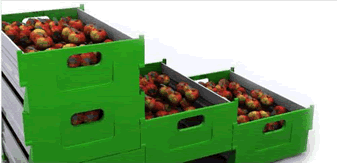 Paula Martins, a student studying for her Masters Degree at ESAD in Caldas da Rainha, Portugal, received an Honorable Mention for her aluminum container used for transporting and displaying fresh produce. The recyclable containers, consisting of two aluminum profiles and two plastic caps, can be easily assembled and stacked replacing single-use wood and cardboard containers. "The design and ‘stackability’ make this an effective merchandising system for produce at market," noted Brown.
Paula Martins, a student studying for her Masters Degree at ESAD in Caldas da Rainha, Portugal, received an Honorable Mention for her aluminum container used for transporting and displaying fresh produce. The recyclable containers, consisting of two aluminum profiles and two plastic caps, can be easily assembled and stacked replacing single-use wood and cardboard containers. "The design and ‘stackability’ make this an effective merchandising system for produce at market," noted Brown.
Honorable Mention: Thermoelectric Device, Submitted by Eric LaFay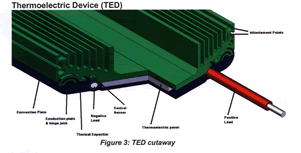
Eric LaFay, a senior studying mechanical engineering at Ohio University in Athens, Ohio, was recognized with a Hydro Sustainable Design Honorable Mention for his concept of an extruded aluminum thermoelectric device. "The device joins two extrusions to generate or remove energy," explained LaFay. "Cooling [is provided] without moving parts or refrigerant; power [is generated] by just having a temperature gradient," according to the designer. "LaFay has designed a clever integral hinge assembly and uses the tight tolerances, thermal properties, and design flexibility of extrusion to create this pollution-free, energy-efficient device," Brown remarked.
 -
-




 |
|